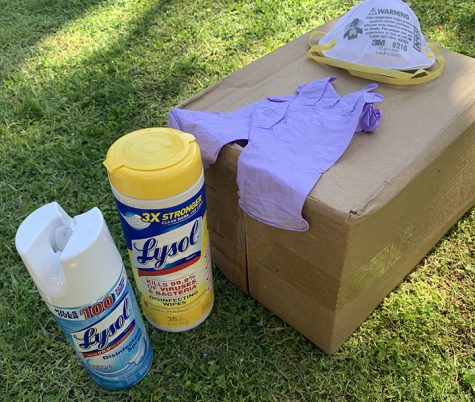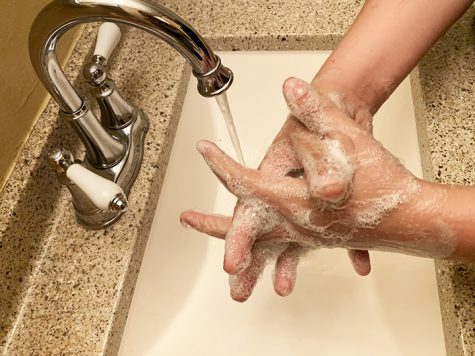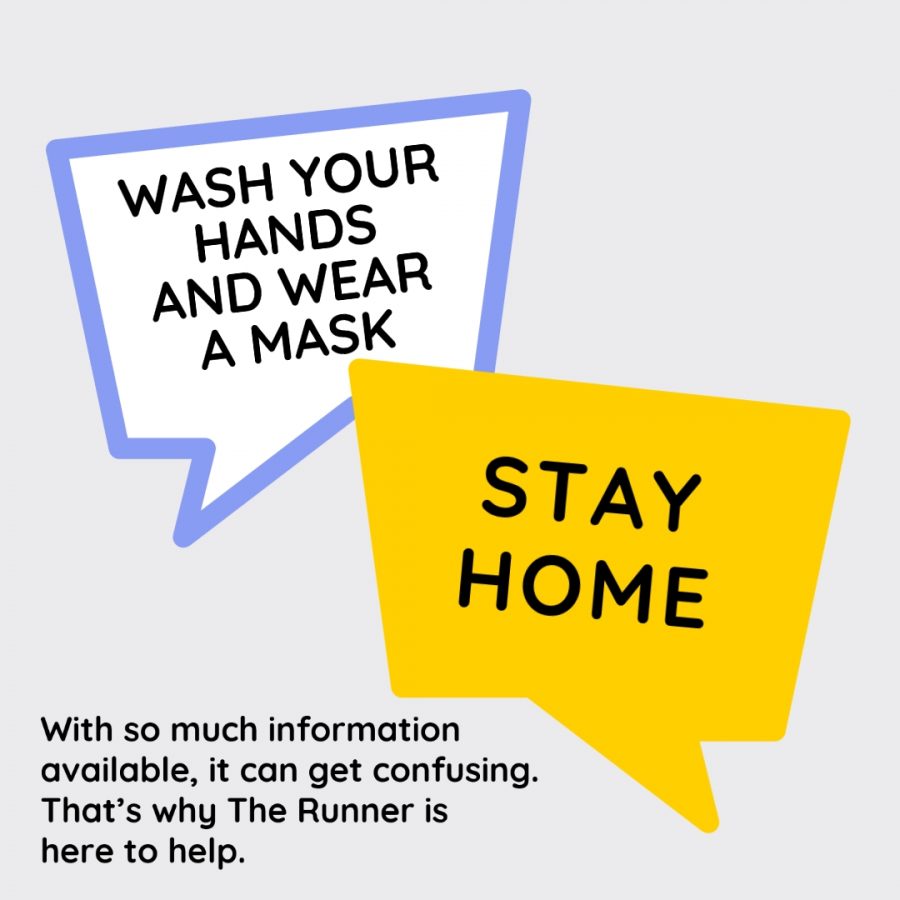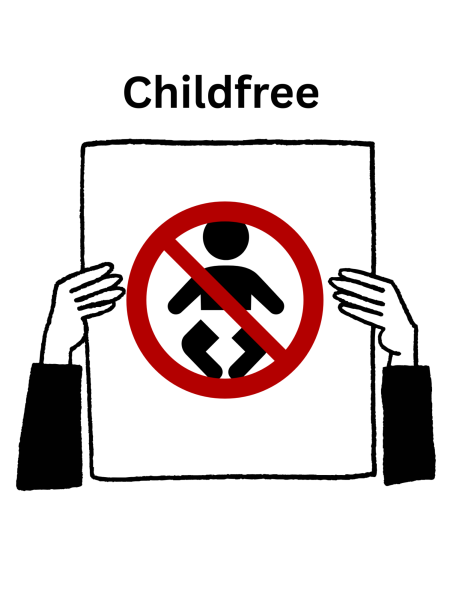Preventing coronavirus: Understanding the protocols
April 15, 2020
As the coronavirus continues to spread across the United States, health organizations such as the Center for Disease Control (CDC) and the World Health Organization (WHO) urge the public to follow the recommended prevention strategies. Residents across the nation have been witnessed rebelling against CDC and WHO recommendations, many taking to social media platforms like Facebook to explain that they feel like they are lacking the proper information.
An abundance of this confusion begins when scrolling through the endless forums discussing the current coronavirus pandemic; there is an abundance of incorrect information available. There are comments about social distancing being a waste, masks being pointless, and conspiracy theories surrounding the purpose of the virus all over chatrooms and comment threads across the web, although many moderators have been trying to remove incorrect information.
In order to help spread the correct information, it is important that we all understand why each recommendation has been made. With an abundance of information available, here’s the highlights of the recommended steps every individual is advised to take to prevent the spread of the coronavirus:
Social distancing
Social distancing is one of the biggest ways to slow the spread of the coronavirus. This includes maintaining a distance of at least six feet from individuals who aren’t a part of your household, avoiding large gatherings, and staying home as much as possible.
“The latest guidelines from Chinese health authorities stated an average incubation duration of seven days, ranging from two to fourteen days,” researchers note in the journal “Infectious Diseases of Poverty.”
This indicates that someone who has contracted the coronavirus could go anywhere from two to fourteen days without knowing they have the virus, or they could be asymptomatic and show no symptoms at all. Here’s an example of how not practicing social distancing can increase the spread of the virus:
Bobby is a cashier at McDonalds. Bobby is exposed to coronavirus during his shift on Monday, but it not aware. Bobby decides to go straight to his girlfriend Samantha’s house after work. Bobby has now unknowingly exposed Samantha and her family. Bobby continues to go to work and visits a friend each day that week. Bobby shows symptoms and tests positive for COVID-19 on Saturday. During that week, Bobby decides to now self-quarantine to avoid spreading the virus. However, Bobby has already given the virus to fourteen people he encountered unnecessarily during the week. With the average coronavirus patient infecting two other individuals, this quickly grows into dozens of new cases. Had Bobby gone to work and gone home, those fourteen people may not have been exposed otherwise.
Utilize a mask or face covering when possible
At this time, research indicates that the three primary ways to contract the coronavirus includes droplet transmission from sources like the saliva released when sneezing, contact transmission from touching something containing the live virus and then touching your face, and through aerosol transmission.
While the common misconception seems to be that face coverings are just meant to filter the air we breathe in, they are also intended to filter the air that we breathe out. Unless you have a surgical or N95 mask, most masks and face coverings have limited effectiveness in keeping you from contracting the coronavirus directly from the air. Instead, the primary function of face coverings is to catch as many of the droplets you breathe out as possible. As many individuals who contract the coronavirus are asymptomatic, it is important to wear a mask even if you do not feel ill. Not only does this reduce the risk of contracting the virus, by however small an amount, it also reduces the risk by unknowing carriers of infecting the air.
On their COVID-19 information page, Harvard explains that the virus is believed to be capable of living in the air for up to three hours. This means that the virus can be left in the air long after the infected individual has left, including by those who are unaware they even have the virus. This emphasizes the importance of wearing a mask or face covering whenever possible to help prevent breathing in or out these micro particles, especially considering the abundance of people who may occupy the same location over three hours in places such as checkout lines.
As N95 and surgical masks need to be reserved for medical personnel in hospitals, there are still options that will help slow the spread of the coronavirus. Paper and cotton masks are good ways to keep covered, as well as utilizing cloth materials such as t-shirts, scarfs, and bandanas. However, cotton masks are still one of the best options, as they are durable and can be washed. At this point, there are a variety of cotton masks available that even have replaceable filters inserted, helping reduce the chances of inhaling or exhaling the virus.
When choosing a cloth face covering, there are a few things you need to be aware of. The material should fit snugly around your face, as well as be sterilizable, breathable, and securable, according to the CDC.
If you are using a reusable face mask or covering, be sure that it is sterilizable. Whether it is designed to be sterilized with an aerosol spray or by being washed in a washing machine, it is important that the face covering is regularly cleaned. As the coverings are designed to serve as a barrier that prevents transmission of the virus, the virus essentially clings to the material. This then requires sterilization to kill and/or remove the virus from the covering, allowing it to safely serve as a barrier against again.
Although the cotton masks are not 100 percent effective at catching the droplets produced by bodily functions such as coughing and sneezing, this does help greatly reduce the number of droplets released to potentially contaminate the air.
For the CDC’s step by step guide to make your own cloth masks, please watch the video below or visit their website at https://www.cdc.gov/coronavirus/2019-ncov/prevent-getting-sick/diy-cloth-face-coverings.html.
Know how to handle frequently touched items and new purchases
Experts express that it is extremely important for frequently touched surfaces, such as door handles and cell phones, to be cleaned often with an approved cleaner. As we can’t always know what viruses and bacteria we have encountered, or what germs others may have touched a shared surface with, it is necessary to ensure that these areas are sterilized to prevent contact transmission.
“A recent study found that the COVID-19 coronavirus can survive up to four hours on copper, up to 24 hours on cardboard, and up to two to three days on plastic and stainless steel,” Harvard writes on their COVID-19 Basics webpage.
An example would be touching a keypad at Target to pay with your debit card; while the stores have stepped up their efforts to clean these surfaces often, it is no guarantee. These germs can then be transferred from your skin to frequently touched surfaces, like your car keys and cell phone. By regularly cleaning these items, it reduces the risk of contact transmission.

Allowing surfaces to air out reduces the risk of contact transmission.
This is also why it is so important to leave new purchases in a safe place where they will not be touched for at least 24 hours, as it reduces the risk of coming into contact with the live virus on surfaces where it has a longer lifespan.
As researchers are currently unsure how the virus may spread from the soles of shoes, especially the shoes worn at work by medical staff, it is important to consider where you may have worn your shoes as well. If you feel you have been in an environment that increases the risk of contamination, such as busy or uncleaned facilities, there are preventative measures that can be taken for those who are concerned. These steps include spraying the shoes with disinfectant spray or allowing them to “air out” in the same manner as a new purchase.
For a list of products verified to work on the coronavirus, please see
https://www.americanchemistry.com/Novel-Coronavirus-Fighting-Products-List.pdf.
Sanitize your hands often
Although sanitizing frequently touched surfaces can help prevent the risk of contracting the coronavirus, no prevention method is foolproof. Sterilizing frequently touched objects is a great way to help reduce the risk of contracting the coronavirus through physical contact with the virus on surfaces, but this only truly works if you also properly wash your hands regularly.

It is recommended that you wash the entire surface of your hands, down to the wrist, as well in small gaps such as between fingers and under your nails.
Health experts recommend washing your hands by lathering with antibacterial soap for at least 20 seconds, taking care to clean under nails and between fingers, and using warm to hot water. While it may seem like the most important aspect is just washing your hands at all, it really only helps prevent COVID-19 if we do it right. It takes 20 seconds of actively lathering with soap to begin to break down the outer layer of the virus, effectively destroying it.
If you find yourself in a place where you can’t wash your hands at that time, try to use hand sanitizer when possible. It needs to be 60% or higher alcohol content in order to kill the coronavirus, and it does help prevent the risk of contact transmission. This helps reduce the risk of transferring the virus from one infected surface, such as the Target keypad, to an uninfected one, like your car keys.
Avoid touching your face
Because viruses can periodically survive hand washing and surface cleaners, one of the most important things you can do is avoid touching your face. The virus is contracted after it enters the body through eyes, nose, and mouth, so these are the surfaces that should be protected the most.
If you must touch your face, such as to eat or apply cosmetic products, it is recommended that you sanitize your hands first.
It takes the effort of every American to flatten the curve.









